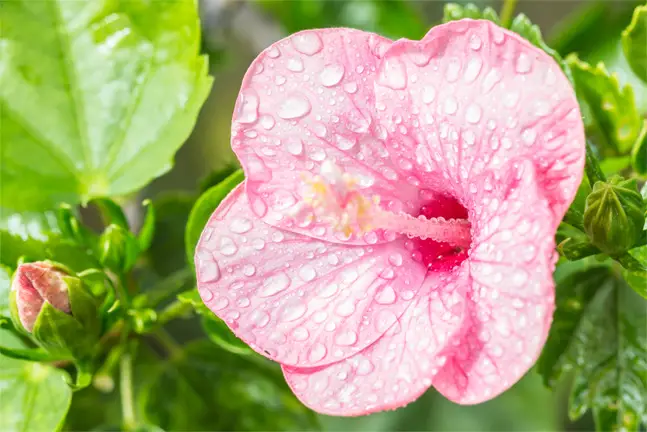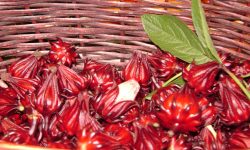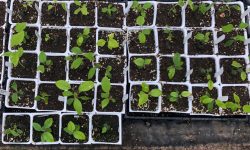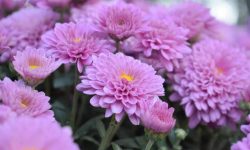Watering hibiscus correctly is one of the most important parts of keeping it healthy and full of blooms. These tropical beauties love warmth and moisture, but they also dislike soggy roots. Too much water can drown them, while too little causes leaves to droop and buds to fall. Finding the perfect balance may seem tricky at first, but once you learn your plant’s rhythm, caring for hibiscus becomes simple and rewarding. Every drop matters, especially when your goal is to grow strong, vibrant plants that bloom nonstop.
The watering needs of hibiscus change depending on where and how you grow it. Indoor plants face dry air and limited sunlight, while outdoor ones deal with heat, wind, and rain. Understanding these differences helps you adjust your watering routine for each environment. Whether your hibiscus lives in a pot or the ground, learning when and how often to water ensures it thrives all year. With the right moisture, your hibiscus will reward you with glossy leaves and spectacular flowers that brighten every corner of your home or garden.
Understanding the Water Needs of Hibiscus

Hibiscus plants thrive in warm, humid environments where moisture is steady but not excessive. Their roots need both water and air to stay healthy. When the soil stays too wet, oxygen levels drop, and roots begin to suffocate. On the other hand, dry soil limits nutrient absorption, causing leaves to curl and buds to fall. Hibiscus plants grow best when the soil stays evenly moist — never soaked, never dry. The key is balance. This balance depends on factors like sunlight, temperature, humidity, and soil type. Learning to read your plant’s signals helps you find the ideal watering rhythm.
The frequency of watering changes between indoor and outdoor conditions. Indoor hibiscus grows in limited airflow and often faces dry indoor air from heaters or air conditioning. As a result, it needs slightly less frequent watering than outdoor plants but benefits from higher humidity. Outdoor hibiscus, especially in warm climates, loses water faster through evaporation and transpiration. Sun, wind, and temperature all influence how fast the soil dries. Understanding these environmental factors prevents both underwatering and overwatering. Each hibiscus plant responds differently depending on its growing space.
The size of the container or planting area also affects water needs. Potted hibiscus dries faster than plants grown in the ground. Smaller pots warm up quickly and lose moisture faster, requiring closer attention. Always check the top inch of soil to decide when to water. If it feels dry, it’s time to give your plant a thorough drink. Mastering this observation helps you maintain strong roots and lush growth. Knowing your hibiscus’s water needs is the foundation of consistent, healthy flowering.
How Often to Water Hibiscus Indoors
Indoor hibiscus plants have unique watering needs that depend on temperature, humidity, and light exposure. Inside the home, airflow is limited, and the soil dries more slowly. Most hibiscus grown indoors need water every three to four days in warm months and every seven to ten days in winter. These numbers change with the season and the pot size. The most reliable way to decide when to water is by touching the top inch of soil. If it feels dry and slightly warm, water deeply until it runs through the drainage holes. Avoid watering if the surface still feels cool or damp. Consistency keeps the roots healthy and prevents stress.
Always use room-temperature water when watering hibiscus indoors. Cold water shocks the roots, while hot water damages delicate tissues. Water slowly and evenly to moisten all parts of the soil. Empty the saucer afterward to avoid standing water. Overwatering leads to root rot, which causes yellowing leaves and slow growth. If your plant shows these symptoms, reduce watering immediately and let the soil dry slightly before resuming. On the other hand, dry, crispy leaves indicate dehydration. In this case, water thoroughly and mist the leaves lightly to restore balance.
Humidity is crucial for indoor hibiscus, especially in heated or air-conditioned rooms. Low humidity dries leaves even when the soil is moist. Mist the plant several times weekly or place it near a humidity tray filled with pebbles and water. Keep the plant away from cold drafts and heating vents that remove moisture from the air. Regular watering, combined with stable humidity, ensures your indoor hibiscus stays lush, glossy, and full of healthy growth throughout the year.
How Often to Water Hibiscus Outdoors
Outdoor hibiscus plants face direct sunlight, wind, and changing temperatures, so their watering needs differ greatly from indoor ones. In warm weather, outdoor hibiscus requires frequent watering to stay hydrated and maintain steady growth. During summer, water daily if temperatures exceed 85°F, as the soil dries quickly under heat. In milder weather, watering every two to three days is often enough. The goal is to keep the soil consistently moist but never waterlogged. Soil that dries completely between waterings causes leaves to wilt and buds to drop. Observing the soil and plant condition helps determine the right schedule for your specific climate.
Morning is the best time to water outdoor hibiscus. Early watering allows moisture to soak deeply before the midday heat evaporates it. Deep watering encourages strong roots that can tolerate short dry spells. Use a gentle stream to soak the soil evenly, focusing around the root zone. Avoid wetting the leaves late in the day, as this creates humid conditions that attract pests and fungus. If rain is expected, skip watering that day to prevent over-saturation. Consistency and timing are key for maintaining vigorous, healthy growth outdoors.
Mulching plays an important role in water management for outdoor hibiscus. A two-inch layer of organic mulch around the base helps retain moisture and stabilize soil temperature. It also reduces weed competition and prevents quick evaporation. In windy or extremely hot areas, mulch becomes essential for protecting roots from dehydration. During cooler seasons, gradually reduce watering as the plant slows growth. Outdoor hibiscus thrives when watered deeply, consistently, and thoughtfully throughout each season.
Factors That Affect How Often to Water Hibiscus
Climate and Temperature
Climate and temperature play the biggest roles in determining how often hibiscus needs water. In hot, dry climates, evaporation happens quickly, and the soil loses moisture faster. Outdoor hibiscus in full sun may need watering every day during heatwaves, while cooler climates require less frequent watering. High temperatures also increase transpiration, meaning the plant loses more water through its leaves. During these conditions, deep watering becomes essential to keep roots cool and hydrated. On the other hand, in mild or rainy regions, too much water can cause soggy soil and root rot. Adjusting your watering schedule with seasonal changes ensures steady growth and prevents stress from over or under-watering.
Humidity also influences how often hibiscus needs moisture. In humid regions, the air holds more water, reducing how quickly the soil dries. Indoor hibiscus grown in air-conditioned or heated rooms often struggles with dry air and needs additional humidity. Maintaining stable conditions helps the plant regulate water use naturally. Observing weather patterns and local climate allows you to adapt your routine effectively. Understanding how temperature and humidity interact gives you better control over your hibiscus watering habits.
Soil Type and Drainage
Soil type and drainage quality directly affect how often hibiscus should be watered. Hibiscus thrives in loose, well-draining soil that holds moisture without staying soggy. Sandy soil dries quickly, requiring more frequent watering, while clay soil holds water longer, increasing the risk of overwatering. To improve clay soil, mix in compost or perlite for better airflow and drainage. Potted hibiscus needs even more attention because containers dry faster and restrict root expansion. Checking the soil regularly helps you adjust water timing before stress appears.
Proper drainage is essential to prevent root rot. Always use containers with holes and avoid letting water sit at the bottom. In the garden, slightly raised beds help excess moisture escape after heavy rain. A healthy balance between moisture retention and drainage allows hibiscus roots to absorb water efficiently. Good-quality soil also provides better oxygen flow, which supports root development and nutrient uptake. Adjusting your watering habits to match soil conditions ensures strong roots, steady growth, and abundant blooms throughout the growing season.
Seasonal Watering Guide for Hibiscus
Spring Watering Routine
Spring is the season when hibiscus awakens from dormancy and begins new growth. As days grow longer and temperatures rise above 60°F, the roots become active again. During this stage, water deeply two or three times a week to maintain consistent soil moisture. Always check the soil before watering; if the top inch feels dry, it’s time. Avoid shallow watering, which leaves roots weak and prone to stress. For plants moved outdoors after winter, increase watering gradually over two weeks to help them adapt to natural sunlight and warmer air. Stable moisture helps build strength for flowering later in the season.
Rainfall can make watering less frequent, but you must ensure good drainage to prevent soggy roots. Mulching helps regulate soil temperature and retains enough moisture between rains. Indoor hibiscus also needs slightly more water as light and warmth increase. As buds start forming, water before and after feeding to help nutrients absorb properly. Morning watering works best for energy flow and evaporation control. Consistent hydration during spring strengthens roots, encourages leafy growth, and prepares your hibiscus to bloom beautifully in summer.
Summer Watering Routine
Summer brings high temperatures, intense light, and rapid evaporation, which means hibiscus needs more frequent watering. Outdoor plants in full sun may need daily watering, especially when temperatures reach 90°F or higher. Always water early in the morning so the roots can absorb moisture before the midday heat. Deep watering encourages strong root systems that handle dry spells better. Avoid shallow watering that only wets the surface.
Potted hibiscus dries faster than garden plants, sometimes needing water twice daily during extreme heat. Mulch helps keep the soil cool and moist, preventing water loss. Indoor hibiscus also needs attention in summer, as air conditioning lowers humidity. Misting or using a humidity tray keeps leaves hydrated and glossy. Never water late at night, since damp leaves under warm air attract fungus. When summer watering is steady and deep, hibiscus rewards you with constant blooms and strong, glossy foliage that stays radiant all season long.
Fall Watering Routine
Fall marks the time when hibiscus begins to slow down after its active summer growth. Cooler air, shorter days, and softer sunlight signal the plant to prepare for dormancy. As temperatures fall below 70°F, gradually reduce watering to match this natural rhythm. Outdoor hibiscus generally needs water every four to five days, while indoor plants can go a week between watering. Always check the top two inches of soil before adding more water. If it feels dry, water slowly and evenly until moisture reaches the roots. Avoid overwatering, since cooler air reduces evaporation and can suffocate the roots. A steady but moderate schedule prevents stress and supports a smooth transition toward dormancy.
In early fall, continue watering enough to help the plant recover from summer heat. By mid-fall, stop fertilizing and space out watering sessions to signal rest. Add a layer of mulch around the base to keep the soil moist and warm. When rainfall increases, check that water drains freely from the surface to avoid puddling. For potted hibiscus, tip the pot slightly after watering to remove excess moisture. Careful, reduced watering during fall prevents fungal issues and prepares your hibiscus for winter’s cooler conditions.
Winter Watering Routine
During winter, hibiscus slows down naturally as temperatures drop and sunlight decreases. Growth nearly stops, so watering must be reduced. Both indoor and outdoor plants need far less water than in warmer months. Indoor hibiscus usually requires watering every 10 to 14 days, depending on room temperature and humidity. Always check the soil before watering; if the surface feels dry but slightly cool underneath, give it a small drink. Use room-temperature water to prevent shock. Avoid soaking the soil because cold, dark conditions delay drying and increase the risk of rot. Consistency is more important than frequency in winter care.
Hardy outdoor hibiscus rarely needs water once the ground freezes. In mild regions without hard frost, give it a light watering every few weeks to prevent the roots from drying out completely. Avoid watering during freezing weather to prevent ice formation around the roots. For indoor plants, maintain moderate humidity with a light mist every few days. Do not fertilize or encourage new growth during this time. Light, steady moisture keeps the roots healthy without stimulating unnecessary activity. When spring warmth returns, gradually increase watering to restart growth. Proper winter watering ensures the hibiscus rests safely and awakens strong, ready to burst with fresh leaves and blooms.
Signs of Overwatering and Underwatering Hibiscus
Overwatering is one of the most frequent watering problems hibiscus growers face. When the soil remains too wet, roots can’t absorb oxygen properly. This lack of airflow weakens the root system and encourages rot. The first visible signs include yellowing lower leaves, soft stems, and a faint sour smell near the base. You might also notice mold forming on the soil surface. In more severe cases, the plant may wilt despite wet soil, showing that the roots have started decaying. To fix this, stop watering until the top layer dries completely. Improve drainage with sand, perlite, or organic matter, and always empty standing water from trays.
Underwatering causes the opposite but equally damaging stress. When hibiscus doesn’t get enough water, leaves curl inward, edges turn brown, and buds fail to open. The soil becomes compact, light-colored, and pulls away from the pot’s edges. Flowers wither quickly after blooming. To rehydrate the plant, water slowly and deeply until moisture drains from the bottom. Allow the plant to rest in indirect light while it recovers. Repeat watering only when the surface begins drying again. Avoid sudden overwatering after long dryness, which can shock roots and cause more leaf drop.
Consistent observation is the best prevention against both watering extremes. Healthy hibiscus soil feels moist yet airy, and leaves appear glossy and firm. If you notice changes in leaf color or texture, adjust watering frequency immediately. Check the pot’s weight to gauge soil moisture — lighter pots usually signal dryness. Over time, learning these subtle signs builds confidence and helps you provide perfect hydration. Balanced watering promotes deep roots, steady growth, and abundant, long-lasting flowers through every season.
Best Watering Techniques for Hibiscus
Watering hibiscus correctly means more than just adding water—it’s about how and when you do it. The most effective method is deep watering, which allows moisture to reach the full depth of the roots. Shallow watering only wets the surface, leaving lower roots dry and weak. To water deeply, pour slowly until water drains from the pot’s bottom or soaks several inches into garden soil. Deep watering encourages strong, drought-resistant roots. Morning is the best time because the plant can absorb water before the midday heat evaporates it. This schedule also allows leaves to dry before night, reducing fungal risks.
Use room-temperature water to avoid shocking roots. Cold water can cause temporary leaf drop, while hot water damages root hairs. If possible, collect rainwater or use filtered water since hibiscus is sensitive to mineral buildup. When watering, focus on the soil around the base instead of the leaves. Wet leaves attract fungal infections, especially in humid climates. For potted hibiscus, water slowly and evenly until the soil feels saturated, then empty excess from saucers. In-ground hibiscus benefits from a light layer of mulch to keep soil temperature stable and moisture consistent.
Consistency and observation matter most. Watering too quickly or at irregular times confuses the plant’s natural rhythm. Adjust your technique based on the season, humidity, and sunlight exposure. During active growth, increase watering frequency slightly. In cooler months, reduce it gradually. Always check soil texture before adding more water. Using proper techniques ensures hibiscus remains hydrated, balanced, and resilient. Healthy watering habits lead to vigorous growth, glossy foliage, and vibrant flowers that last from spring through fall.
Common Watering Mistakes to Avoid
Watering on a Fixed Schedule
One of the most common watering mistakes is sticking to a strict schedule instead of observing the plant. Hibiscus watering needs shift constantly based on temperature, sunlight, and soil condition. Many gardeners water automatically every day or on specific days without checking the soil first. This habit often leaves roots in wet conditions for too long, cutting off oxygen and leading to rot. Yellowing leaves, drooping stems, and premature leaf drop are early signs of excessive watering. To prevent this, always check the top inch of soil before watering. If it feels cool or damp, wait another day. Adjust your watering rhythm according to the plant’s environment and daily changes.
Hibiscus thrives on consistency, not routine. In hot, dry weather, it needs more frequent hydration, while in cooler, humid days, it requires much less. A plant growing in full sunlight will dry faster than one in partial shade. Rather than following a calendar, watch for subtle signs such as leaf texture and soil color. When you respond to your hibiscus’s actual needs, it develops deeper roots, greener foliage, and stronger blooms that last longer through each growing cycle.
Pouring Water Too Quickly or on the Leaves
Watering too quickly is another mistake that prevents hibiscus from absorbing enough moisture. Fast watering wets only the surface and leaves the deeper roots dry. Over time, this weakens the root system and limits growth. To fix this, water slowly and allow time for the soil to absorb moisture evenly. A gentle, steady pour helps water reach the full depth of the pot or planting bed. This technique promotes deep rooting and increases the plant’s resilience to heat. Proper watering keeps the soil soft and breathable while preventing uneven drying.
Watering the leaves directly creates different problems. In strong sunlight, droplets act like magnifying glasses, burning the foliage. Under humid conditions, damp leaves invite mold, mildew, and pests. Always water at the base and avoid overhead watering unless necessary. If your hibiscus is dusty, clean the leaves separately with a damp cloth. Using room-temperature or rainwater also improves plant health since hibiscus dislikes chlorinated water. Deep, even watering at the soil level encourages balanced hydration, better nutrient absorption, and a healthier, longer-living hibiscus.
Ignoring Proper Drainage
Poor drainage is one of the main reasons hibiscus plants struggle to survive. Without proper drainage, water builds up around the roots, cutting off oxygen and promoting fungal decay. The soil stays soggy, and soon leaves begin turning yellow or curling. To prevent this, always choose pots with wide drainage holes. For outdoor hibiscus, plant them in raised beds or sloped areas where rainwater drains naturally. Well-draining soil keeps the root zone airy and encourages strong, steady growth.
Soil structure also plays a major role in drainage. Heavy clay traps water, while sandy soil dries too quickly. The best mix combines compost, sand, and perlite for both moisture retention and airflow. After watering, check trays and saucers for excess water and empty them immediately. Adding mulch around the base helps regulate soil moisture without causing oversaturation. Good drainage not only prevents root rot but also helps hibiscus absorb nutrients more efficiently. A plant growing in well-aerated soil stays vibrant, develops sturdy stems, and rewards you with bright, long-lasting blossoms every season.
How to Adjust Watering in Different Conditions
Different growing conditions affect how often hibiscus needs water. In hot and dry weather, the soil dries out quickly, and the plant loses moisture through its leaves. During heatwaves, water deeply once or twice daily to keep the roots cool and hydrated. Morning watering works best because it allows moisture to reach the roots before the day’s heat increases evaporation. Always check the soil before adding more water. Deep, slow watering encourages stronger roots and helps the plant survive intense sunlight. Using mulch around the base also protects the soil from overheating and reduces water loss.
In rainy or humid conditions, hibiscus needs less frequent watering. The soil may appear dry on top but remain wet beneath the surface. Overwatering in humid weather easily leads to fungus and root rot. Check soil moisture two inches deep before watering again. Ensure good drainage by loosening compact soil and slightly reducing mulch thickness to let air circulate. In regions with heavy rainfall, avoid watering unless the soil dries completely. If your hibiscus grows in pots, tilt them after storms to let excess rainwater drain freely. Proper water management during humid weather prevents fungal issues and supports steady, healthy growth.
Indoor or shaded hibiscus plants require different care. With lower light and limited airflow, evaporation slows, so watering should happen once every five to seven days. Always allow the topsoil to dry slightly between watering. Dry indoor air can stress the plant, so misting the leaves lightly helps maintain humidity. Keep the plant near bright, indirect sunlight and away from vents or cold drafts. Adjusting watering to suit your plant’s environment keeps hibiscus strong, hydrated, and ready to bloom beautifully year-round.
FAQs About Watering Hibiscus
How often should I water hibiscus in summer?
In summer, hibiscus needs frequent watering due to heat and strong sunlight. Water deeply once a day or twice during extreme heat. Always check the soil before watering again. Morning watering helps reduce evaporation and keeps the roots cool, encouraging healthy growth and vibrant, long-lasting blooms.
Can I use tap water for hibiscus plants?
You can use tap water if it’s not high in chlorine or fluoride. Let it sit overnight before watering to allow chemicals to dissipate. Rainwater or filtered water is ideal because hibiscus prefers slightly soft water. Using clean, balanced water prevents leaf spots and supports steady, strong flowering.
Why are my hibiscus leaves turning yellow after watering?
Yellow leaves usually mean overwatering or poor drainage. The roots may lack oxygen if the soil stays wet for too long. Check your pot’s drainage holes and reduce watering frequency. Allow the topsoil to dry before the next watering. Proper drainage and balanced moisture restore healthy green leaves quickly.
How do I know if my hibiscus needs water?
Check the top inch of soil by touch. If it feels dry and warm, water thoroughly. If it’s still cool or moist, wait another day. Hibiscus leaves also give clues—drooping or curling often signals dryness. Regular checking helps you maintain consistent moisture and prevent watering mistakes.
Should I mist my hibiscus daily?
Misting helps maintain humidity, especially indoors or during dry weather. Mist lightly in the morning so leaves dry by evening. Avoid over-misting, which promotes fungus. Instead, focus on consistent soil moisture and good airflow. Balanced misting keeps foliage glossy and supports steady growth through all seasons.
Conclusion
Watering hibiscus properly is the secret to its strength, color, and endless blooms. Each plant thrives when moisture, sunlight, and care work in harmony. Whether growing indoors or outdoors, understanding how often and how deeply to water makes all the difference. Small adjustments prevent stress, boost root health, and encourage lush growth. When you master the rhythm of watering, your hibiscus rewards you with vibrant flowers that brighten every season. Consistent attention and mindful care turn this tropical beauty into a thriving, year-round symbol of warmth and life.






